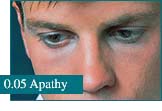The Tone Scale is an extremely useful tool to help predict the characteristics and behavior of a person. But to do this well you must be able to recognize a person’s position on the scale at a glance.
The Tone Scale is very easy to apply on a casual basis for some acute tone. “Joe was on a 1.5 kick last night.” Sure, he turned red as a beet and threw a book at your head. Simple. Mary breaks into sobs, and grabs for the Kleenex, easily recognizable as grief. But how about a person’s chronic tone level? This can be masked by a thin veneer of social training and responses. Such is called a social tone. It is neither chronic, nor acute, but is a reflection of the person’s social education and mannerisms adopted to present himself to others. How sharp and how certain are you about that? Take a person that you are familiar with. What, exactly, is his chronic tone?
There is a word “obnosis” which has been put together from the phrase, “observing the obvious.” The art of observing the obvious is strenuously neglected in our society at this time. Pity. It’s the only way you ever see anything; you observe the obvious. You look at the isness of something, at what is actually there. Fortunately for us, the ability to obnose is not in any sense “inborn” or mystical. But it is being taught that way by people outside of Scientology.
How do you teach somebody to see what is there? Well, you put up something for him to look at, and have him tell you what he sees. An individual can practice this on his own or in a group situation, such as a class. One simply selects a person or object and observes what is there. In a classroom situation, for instance, a student is asked to stand up in the front of the room and be looked at by the rest of the students. An instructor stands by, and asks the students:
“What do you see?”
The first responses run about like this:
“Well, I can see he’s had a lot of experience.”
“Oh, can you? Can you really see his experience? What do you see there?”
“Well, I can tell from the wrinkles around his eyes and mouth that he’s had lots of experience.”
“All right, but what do you see?”
“Oh, I get you. I see wrinkles around his eyes and mouth.”
“Good!”
The instructor accepts nothing that is not plainly visible.
A student starts to catch on and says, “Well, I can really see he’s got ears.”
“All right, but from where you’re sitting can you see both ears right now as you’re looking at him?”
“Well, no.”
“Okay. What do you see?”
“I see he’s got a left ear.”
“Fine!”
No guesses, no assumptions will do. For example, “He’s got good posture.”
“Good posture by comparison with what?”
“Well, he’s standing straighter than most people I’ve seen.”
“Are they here now?”
“Well, no, but I’ve got memories of them.”
“Come on. Good posture in relation to what, that you can see right now.”
“Well, he’s standing straighter than you are. You’re a little slouched.”
“Right this minute?”
“Yes.”
“Very good.”
The goal of such drilling is to get a student to the point where he can look at another person, or an object, and see exactly what is there. Not a deduction of what might be there from what he does see there. Just what is there, visible and plain to the eye. It’s so simple, it hurts.
You can get a good tip on chronic tone from what a person does with his eyes. At apathy, he will give the appearance of looking fixedly, for minutes on end, at a particular object. The only thing is, he doesn’t see it. He isn’t aware of the object at all. If you dropped a bag over his head, the focus of his eyes would probably remain the same.
Moving up to grief, the person does look “downcast.” A person in chronic grief tends to focus his eyes down in the direction of the floor a good bit. In the lower ranges of grief, his attention will be fairly fixed, as in apathy. As he starts moving up into the fear band, you get the focus shifting around, but still directed downward.
At fear itself, the very obvious characteristic is that the person can’t look at you. People are too dangerous to look at. He’s supposedly talking to you, but he’s looking over in left field. Then he glances at your feet briefly, then over your head (you get the impression a plane’s passing over), but now he’s looking back over his shoulder. Flick, flick, flick. In short, he’ll look anywhere but at you.





What a person does with his eyes can help you spot his position on the Tone Scale.
Then, in the lower band of anger, he will look away from you, deliberately. He looks away from you; it’s an overt communication break. A little further up the line and he’ll look directly at you all right, but not very pleasantly. He wants to locate you-as a target.
Then, at boredom, you get the eyes wandering around again, but not frantically as in fear. Also, he won’t be avoiding looking at you. He’ll include you among the things he looks at.
Equipped with data of this sort, and having gained some proficiency in the obnosis of people, a person can next go out into the public to talk to strangers and spot them on the Tone Scale. Usually, but only as a slight crutch in approaching people, a person doing this should have a series of questions to ask each person, and a clipboard for jotting down the answers, notes, etc. The real purpose of their talking to people at all is to spot them on the Tone Scale, chronic tone and social tone. They are given questions calculated to produce lags and break through social training and education, so that the chronic tone juts out.
Here are some sample questions used for this drill: “What’s the most obvious thing about me?” “When was the last time you had your hair cut?” “Do you think people do as much work now as they did fifty years ago?”
At first, the persons doing this merely spot the tone of the person they are interviewing-and many and various are the adventures they have while doing this! Later, as they gain some assurance about stopping strangers and asking them questions, these instructions are added: “Interview at least fifteen people. With the first five, match their tone, as soon as you’ve spotted it. The next five, you drop below their chronic tone, and see what happens. For the last five, put on a higher tone than theirs.”
What can a person gain from these exercises? A willingness to communicate with anyone, for one thing. To begin with, a person can be highly selective about the sort of people he stops. Only old ladies. No one who looks angry. Or only people who look clean. Finally, they just stop the next person who comes along, even though he looks leprous and armed to the teeth. Their ability to confront people has come way up, and a person is just somebody else to talk to. They become willing to pinpoint a person on the scale, without wavering or hesitating.
They also become quite gifted and flexible at assuming tones at will, and putting them across convincingly, which is very useful in many situations, and lots of fun to do.
Being able to recognize the tone level of people at a single glance is an ability which can give a tremendous advantage in one’s dealings with others. It is a skill well worth the time and effort to acquire.